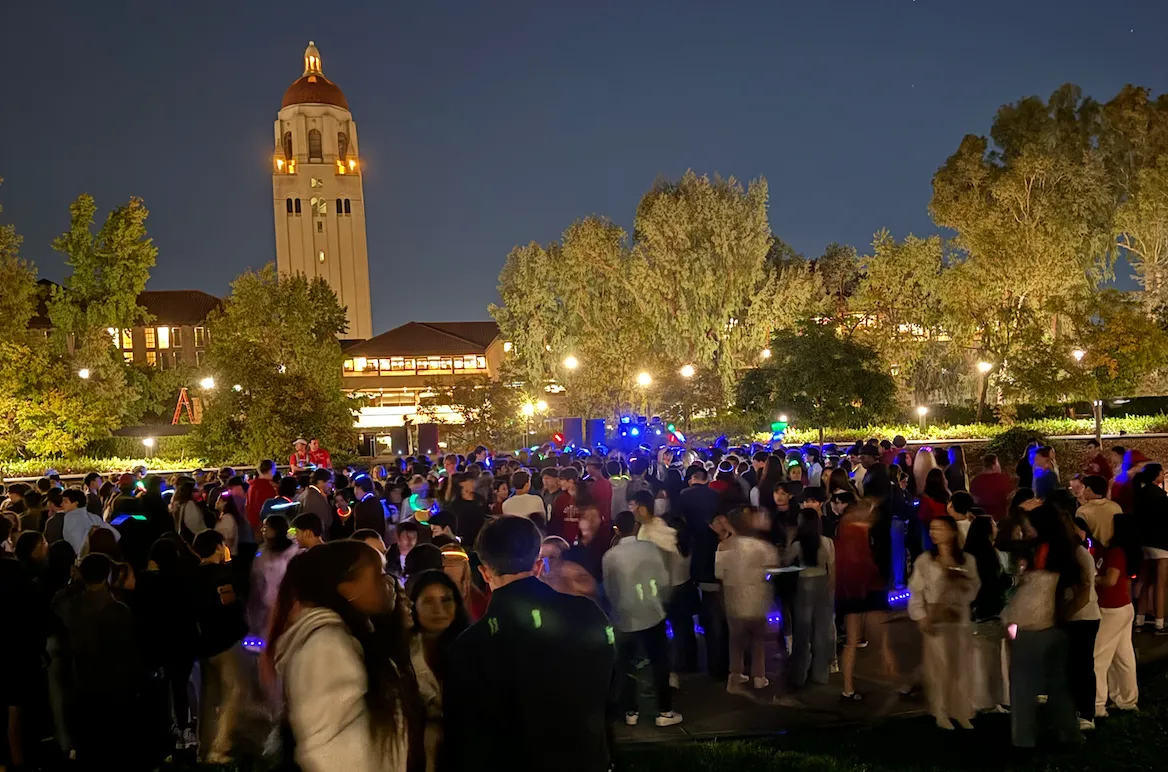Table of Contents
At the start of January, returning Stanford students were greeted by the sight of a full Lake Lagunita. After weeks of rain storms across the Bay Area, the water level at Lake Lag rose steadily over winter break, transforming the barren basin at the back of the campus into a beautiful lake. Despite an announcement discouraging “recreational activities,” students soon started paddling, cycling, and swimming through the lake, making it a lively center of leisure at all times of the day.
For a school plagued by a crisis in fun, the return of Lake Lag and students’ defiance of school rules to enjoy themselves seemed to be a return to the irreverent Stanford of years past. However, despite the enthusiastic joy of the student body at the sight of a refilled lake, there had been little discussion on the future of Lake Lag. Other than the aforementioned announcement and a statement passed to the Daily, there were no other communications from the school. Surprisingly, there has been no student movement campaigning to keep the lake full.
This lack of discussion is especially surprising when a full Lake Lag brought to light the real reason it’s empty... We had known that Lake Lag was drained for its impact on the endangered tiger salamanders—or so we thought until a statement passed to and published in the Daily showed otherwise. University spokeswoman Luisa Rappor said, “tiger salamanders […] are not the reason why the reservoir is not filled to former recreational levels.” Instead, the pause on artificially maintaining water levels in Lake Lag was because “[it] would put excessive strain on declining steelhead trout populations” in the San Francisquito Creek (a tributary that flows from the Portola Valley into the Bay). The university argues that filling the lake would cause San Francisquito Creek’s water level to decline.
This statement implies a notable change in the discussion of refilling Lake Lag. For once, the crux of this issue rests not on the status of Lake Lag being full or empty, but on the means by which Lake Lag is filled. Indeed, in the same article, the author notes explicitly that “the plan does not address whether alternative sources could be used to fill Lake Lag for recreational activities.”
Instead of tackling the moral question of threatening endangered tiger salamanders with the happiness of students, we are instead presented with a more approachable question of scarcity and economics, of apportioning water resources and our means of obtaining them optimally. The question of refilling Lake Lag now becomes one of cost rather than ethics.
In my unqualified opinion, I would be willing to suggest a few likely—but possibly deficient—methods of diverting water to Lake Lag. For one, if given a poll of all current students, I would wager that many would prefer to fill Lake Lag over watering several of Stanford’s less frequented gardens. If it’s prioritized, a campaign of triaging outdoor water use can divert water to Lake Lag. The “loss of 500 gallons of water a minute” through the floor of Lake Lag is concerning, but this might be a great way to put dirty water to use... another possibility may be the diversion of campus wastewater to Lake Lag. Sure, that would not be appealing, but it is already rumored that the current lake was refilled by sewer water, and it is established that wetlands could work to filter wastewater.
However, we need not be paralyzed over the exact details of such a plan—this can be resolved at a later date. Instead, what we need is to start demanding that Lake Lag is saved and incorporated it as an integral part of campus.
The positives of a refilled Lake Lag are innumerable. Already, the social effects of the refilled lake and its improvement of student life had been apparent—everyone loves to hang out near (or even on) the lake. Official recognition of the filled lake as a lasting part of the campus can provide university-approved and supported social events for a larger number of students. The refilled lake would also bring these recreational and social benefits to not only the student body and wider campus community but even to residents of the surrounding communities like Palo Alto and Menlo Park.
Beyond social life, there are many other practical reasons for restoring Lake Lag. A simple trip to the lake shows the return of wildlife, with the croaking of frogs and the sight of waterfowl. Further, it could also be a useful tool in fighting ongoing drought or January rainstorms. In the future, Lake Lag can act as a reservoir to alleviate rainstorms and prevent flood damage in surrounding areas. It might also be handy during California’s dry summers or fire seasons.
The ultimate question behind refilling Lake Lag is not in the economic calculation, but in the lack of student interest in working towards a fun Stanford. We can’t reasonably argue for a fun, irreverent Stanford if we must rely on directions from the school administration. If we as a student body are concerned for student life and still capable of undirected social action, it is imperative for us to save Lake Lag.








